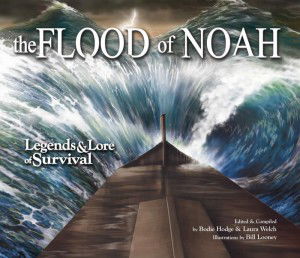The Flood of Noah: Legends & Lore of Survival
The book begins with a brief overview of the many Flood legends found worldwide; listing some of the commonalities found in several legends. Then it moves to a discussion of the Lake Missoula flood that occurred during the Ice Age that followed the global Flood. The amount and extent of the geological carving of the Pacific Northwest by this regional flood showcase the catastrophic power of water to erode rock and create features that otherwise would be interpreted by secular geologists to be uniformitarian processes that took millions of years. If a regional flood can alter the landscape over 2,000 square miles, imagine what a year-long global Flood could do!
We then are given some of the names of Noah and his wife in the different cultures’ Flood accounts from around the world. Quite a few of the accounts have the name of Noah, or a very similar name like Nuah, Noe, Noeh, Nol, or Nu’u. Why would cultures as far away as China, Ireland, and Hawaii have similar names for the patriarchal figure who survived a great Flood unless there was an actual worldwide Flood with human survivors and the account was passed down almost universally?
Pages 9–11 are part of a massive four-page fold-out which includes a cutaway of the Ark, showing potential animal enclosures and cargo bays. Page 12 has a mini-book which lists the many mentions of Noah in the rest of Scripture, proving that Jesus Christ and the writers of Scripture in both Old and New Testaments accepted the veracity of the Flood account and a historical Noah.
Another interesting mini-book contains pictures of different world maps that depict Noah’s Ark. Showcasing maps from the 13th to the 17th centuries, you can see how mapmakers from Germany, England, and France depicted the Ark in or around the regions of Armenia.
The next (and largest) section of the book delves into details of the many Flood legends around the world. Many share common details with the biblical account, but all have some obvious mythological embellishments and fanciful details, which are clearly contrasted with the straightforward account in Genesis 6–9. We weave our way through places such as China, India, North America, Fiji, Lithuania, Central Africa, Greece, and Australia, just to name a few. The preponderance of Flood legends in all these areas scattered across the globe highlights the historical remembrance of such a catastrophe. In a biblical worldview where all the descendants of the earth came from Noah’s family, this type of collective human recounting of cataclysm, survival, and consequent repopulation of the earth (even though corrupted from the original account) is perfectly understandable and in line with what we would expect.
The last section of the book examines this pan-cultural remembrance of a worldwide Flood in light of the scattering of nations at Babel. The sons and grandsons of Noah’s sons, who had heard the account of the Flood first-hand, now were scattered. As they repopulated the earth and moved to new lands, they retold (and embellished) the true account and it morphed into a corrupted mythology over many generations. The similarities to and differences from the Genesis account can be easily understood when one examines human history within a biblical worldview.
The book closes with a reminder that the account of Noah’s Ark is one of Noah and his family being saved by God out of a wicked generation, and that Scripture teaches that we also need to be saved out of a wicked and perverse generation (Acts 2:40; Philippians 2:15). We are reminded by the authors that there is only one way of salvation, Jesus Christ (Acts 4:12, 16:31). And, just like in the days of Noah, mankind will deliberately suppress the knowledge of God (Romans 1:18–20) and willfully forget that the Flood ever happened (2 Peter 3:5–7). The Flood of Noah’s day was a time of great judgment, but also a time of salvation and renewal, which is a figure of the death, burial, and resurrection of Jesus Christ and the newness of life which can be found in Him (Romans 6:4–6; 1 Peter 1:21–25) and Him alone (John 11:25). What a great way to close the book, and what a great God we serve!
I would encourage you to check out this book in our online store and consider getting one so that you and your family can be informed and equipped with answers about the Flood.
And what a great book for a family (kids, teens, and adults) to use as a devotional—they can all learn these wonderful truths together.
Thanks for stopping by and thanks for praying,
Ken
This item was written with the assistance of AiG’s research team.

Answers in Genesis is an apologetics ministry, dedicated to helping Christians defend their faith and proclaim the good news of Jesus Christ.
- Customer Service 800.778.3390
- © 2024 Answers in Genesis



